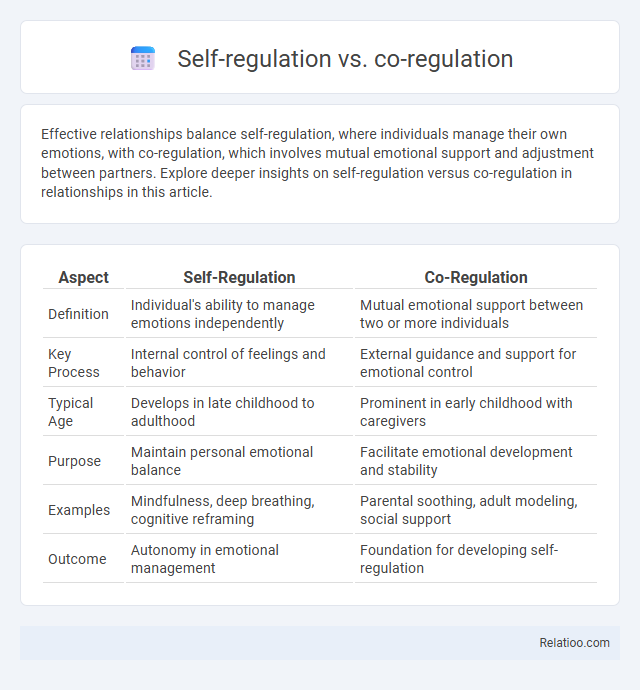Effective relationships balance self-regulation, where individuals manage their own emotions, with co-regulation, which involves mutual emotional support and adjustment between partners. Explore deeper insights on self-regulation versus co-regulation in relationships in this article.
Table of Comparison
| Aspect | Self-Regulation | Co-Regulation |
|---|---|---|
| Definition | Individual's ability to manage emotions independently | Mutual emotional support between two or more individuals |
| Key Process | Internal control of feelings and behavior | External guidance and support for emotional control |
| Typical Age | Develops in late childhood to adulthood | Prominent in early childhood with caregivers |
| Purpose | Maintain personal emotional balance | Facilitate emotional development and stability |
| Examples | Mindfulness, deep breathing, cognitive reframing | Parental soothing, adult modeling, social support |
| Outcome | Autonomy in emotional management | Foundation for developing self-regulation |
Understanding Self-Regulation
Understanding self-regulation involves the ability to manage one's emotions, behaviors, and thoughts independently to achieve long-term goals. Self-regulation contrasts with co-regulation, where external support or guidance helps manage these processes, often seen in caregiver-child interactions. Social cues play a crucial role in both self- and co-regulation by providing contextual information that influences emotional and behavioral responses.
What is Co-Regulation?
Co-regulation is a dynamic process in which a caregiver or trusted individual provides external support to help another person manage emotions and behavior, especially in early childhood development. It involves responsive interaction where the adult attunes to the child's needs, fostering emotional stability and gradually promoting independent self-regulation skills. This interactive mechanism contrasts with self-regulation, where the individual independently controls responses, and is influenced by social cues that signal appropriate emotional or behavioral adjustments within social contexts.
Key Differences Between Self-Regulation and Co-Regulation
Self-regulation involves an individual's ability to manage emotions, behaviors, and attention independently, relying on internal strategies such as mindfulness and impulse control. Co-regulation, by contrast, refers to the interactive process where caregivers or peers support and guide an individual's emotional and behavioral responses, providing external scaffolding during challenging situations. Social cues serve as critical signals within both self-regulation and co-regulation contexts, influencing how individuals interpret and respond to environmental demands.
The Importance of Emotional Awareness
Emotional awareness plays a critical role in differentiating self-regulation, co-regulation, and social cues, as it enables You to recognize and manage your emotions independently while also understanding others' signals during interpersonal interactions. Self-regulation involves your ability to control emotions internally, whereas co-regulation requires attunement to another person's emotional states, creating a supportive environment for emotional balance. Social cues act as external indicators that guide emotional responses and foster empathy, making emotional awareness essential for navigating these complex dynamics effectively.
Strategies to Foster Self-Regulation
Strategies to foster self-regulation include promoting mindfulness practices, setting clear goals, and encouraging emotional awareness to help individuals manage their thoughts and behaviors independently. Implementing structured routines and teaching problem-solving skills support gradual development from co-regulation, where guidance from caregivers or peers is prevalent, to autonomous self-regulation. Recognizing social cues, such as body language and facial expressions, enhances self-regulation by improving social interaction and emotional control in various environments.
Effective Co-Regulation Techniques
Effective co-regulation techniques involve guiding Your child's emotional responses through empathetic communication, consistent routines, and modeling appropriate behavior to build self-regulation skills gradually. Recognizing social cues such as facial expressions and tone helps tailor interventions that support emotional understanding and impulse control. Employing these strategies bridges the gap between self-regulation and co-regulation, fostering emotional resilience and interpersonal competence.
Benefits of Self-Regulation in Daily Life
Self-regulation enhances your ability to manage emotions, maintain focus, and adapt to changing environments, leading to improved decision-making and reduced stress. Unlike co-regulation, which relies on external support, self-regulation fosters independence and resilience by cultivating internal control mechanisms. Recognizing social cues remains important, but strong self-regulation provides a foundation for interpreting and responding to these signals effectively in daily interactions.
The Role of Relationships in Co-Regulation
Co-regulation involves dynamic interactions where caregivers or peers help manage an individual's emotional state, highlighting the significance of secure relationships in fostering emotional development. Your ability to self-regulate improves through consistent social cues and supportive co-regulation processes that model appropriate responses. These interconnected relationships provide the foundation for interpreting social cues and developing independent self-regulation skills over time.
Challenges in Developing Regulatory Skills
Developing regulatory skills faces challenges including the complexity of distinguishing self-regulation, co-regulation, and social cues, as each requires different cognitive and emotional capabilities. Children struggling with self-regulation often depend heavily on co-regulation from caregivers, complicating their ability to internalize control mechanisms essential for independent behavior management. Difficulty in accurately interpreting and responding to social cues further hampers the development of effective regulatory skills, leading to potential social and emotional difficulties.
Integrating Self-Regulation and Co-Regulation for Growth
Integrating self-regulation and co-regulation enhances emotional resilience and fosters social competence, enabling you to navigate complex interpersonal interactions effectively. Self-regulation involves internal processes to manage emotions, while co-regulation depends on external support systems, such as caregivers or peers, guiding emotional responses. Understanding social cues bridges these strategies, allowing seamless transitions between independent regulation and social collaboration for personal and relational growth.

Infographic: Self-regulation vs Co-regulation
 relatioo.com
relatioo.com